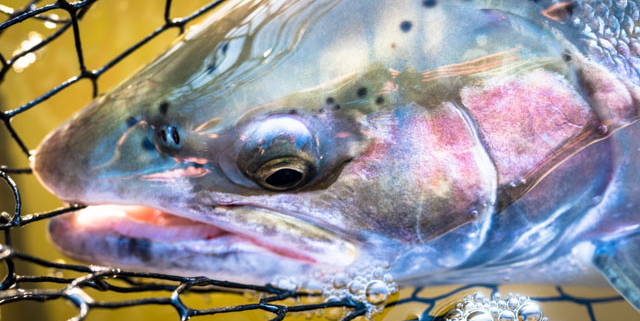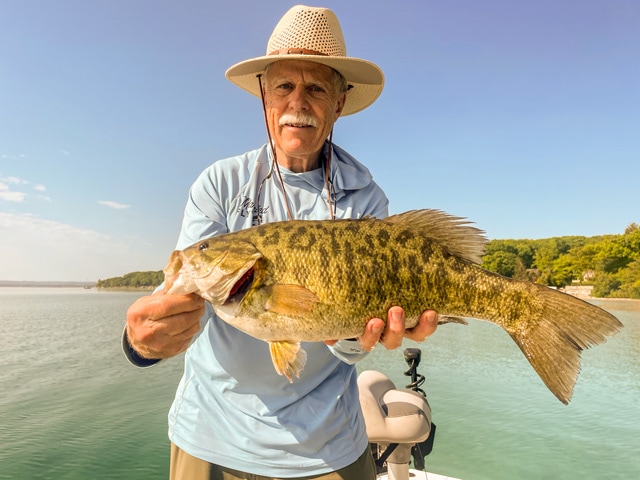Changing Floats based on Water Type
I can still remember the day when the light bulb turned on and I finally understood the need to change my float to match the water type I was fishing. Changing floats based on water type isn’t something you hear much about. Actually it’s a simple change that can make a big difference, especially in the spring, when steelhead themselves are changing the water types they utilize.
Fishing Story
Let’s start with a real world scenario, or as I like to commonly refer to it, my lightbulb moment. It was December and I just spent the past 60 days fishing for steelhead on the lower Manistee River, the section closest to Lake Michigan. Most of those days were spent primarily fishing floats in the lower end of the river. I had my confidence rig all setup and ready to go and for whatever reason I decided to change it up and shift the guide trip towards Tippy Dam.
In the first few hours of fishing we had what I would call opportunities, but no official hookups. To me an opportunity can be defined by when the float drops or is taken down, but the end result is no fish is actually hooked. I positioned the boat to fish what I would consider to be a gimme pool or pocket, basically a spot we should be guaranteed a hookup in. It’s a small run that I have fished over time and learned exactly where the fish will sit. It’s one spot and one spot only in this pool! All we need to do is make the cast, let it drift, count to 3, and the float should drop. Well, on the first cast the float dropped and did exactly what I was hoping for, but once again no official hookup.
On second cast in the same pool we had similar results; cast, mend, feed line, and started the countdown 3 -2 -1…. the float dropped in the same spot and yet again no official hook up. After the 3rd and 4th cast with the same results I had seen enough. Was the float set too deep? Was I hitting the bottom? Was my hook sharp? After weighing all of my options I decided to change the rigging and took off my confidence rig from the lower river and made a change.
Change your Float
The modification was pretty simple. I replaced my homemade balsa float with a smaller and thinner design called a Loafer float. I placed a little less split shot on the leader to properly balance out the float, tied on the same egg pattern, and we were ready to go. I then asked my client to make a few more casts in the same pocket for kicks and giggles.
I’m pretty sure he thought that the bottom was going to bite the same way it had on the previous 4 drifts we already completed. I was also a little apprehensive, but I knew that this pocket was really good and I knew I had my previous rig set to the proper depth, right? So we make the cast, give it a mend, begin feeding line, and start the count down into the hot spot 3 -2 -1…. then the float drops and we finally have a fish on! So what really just happened, what did we actually change?
Lessons Learned
After a great battle to the net and landing that steelhead, a couple of high fives, a good picture and solid release, there was a pure moment of reflection. What did I just learn? Why was it the first couple of drifts were not successful in a hook up? Was this a totally random event? For the rest of the day we would slide into different runs and pockets while fishing the water just downstream of Tippy Dam and proceed to have a good day of catching both steelhead and brown trout.
So looking at the start of our day, with no official hookups, and then comparing that to the end of our day, with a rigging change to our float, how do we interpret the resulting success of our day? The takeaway message for me was changing your float based on water type is very important! Lesson learned and I took this knowledge into the following spring with continued success.
Loafer Floats vs Big Balsa Floats
One of the challenges with larger Balsa floats that have shorter bottom stems is that they can get pushed around by surface currents. This was a classic example of the hydrologic influence we observed when I was fishing near Tippy Dam. Complex current seams make it harder for the bigger floats to track properly thus speeding up your presentation and consequently not allowing you to match the correct speed of your offering along the bottom. The end result is the larger Balsa Floats create drag on your terminal offering and we all know fish do not like drag.
Slimmer profile floats in the Loafer design have less surface area and allow better float control. Loafers, which are tubular in shape, are balanced by the longer stem at the bottom for precision tracking. The float design has less surface area at the top of the float and more of the float body below the waterline which prevents it from being pushed around by the current. The other advantage of the Loafer style float is they allow your float to stay in the current seam even when aggressively mending your line.
The current speeds closer to Tippy Dam are much faster than the current speeds where I had been fishing in the lower river. When the steelhead would grab our offering in the gimme pocket he could feel the weight of the larger Balsa float and would let go before we could do anything about it. The slimmer Loafer float didn’t have the same surface tension influencing it, which didn’t allow the steelhead an opportunity to reject our offering thus allowing us to hook the fish.
Colder temps in December also played a role in how aggressive the steelhead by the dam were feeding, with the dropping temperatures that day fish were not running away with our offering. Dropping temps and tempered feeding behavior were also important reasons for making a float change on this day.
Balsa in the Big Water

One of the greatest attributes an angler can have is the power of observation. By being observant and making one simple change, you can sometimes find unintended success! The Loafer design is a great float, but one of its fatal flaws is it is fragile. With the thinner and longer stem design, they like to break. I have run both the balsa and plastic models and they both have a tendency to break. They may be fragile by comparison, but the Loafer floats can help you catch a lot of fish in the faster water that spring steelhead tend to utilize as we get closer to spring.
I have caught plenty of fish in the lower end of the river on Loafer floats as well, but day in and day out I still prefer the bigger balsa floats for that water type. Both my custom made and store bought float designs work great, but I do recommend carrying a few different styles of floats in a few different sizes to meet your needs based on conditions. Don’t be afraid to play around and experiment and just remind yourself the next time you’re fishing and you can’t get a bite to try changing floats based on water type might be the ticket. It’s a simple trick, but it may be the answer on a day where the conditions and fishing are not matching up. Good luck on the water this spring and tight lines.
Jon Ray





Comments are closed.